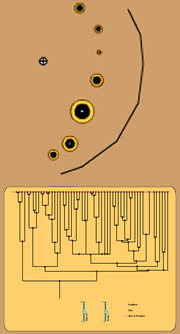Ancient wings unfurled
Computer simulation reconstructs extinct butterfly
patterns.
27 October 2003
JOHN WHITFIELD
 |
| Wing patterns resurrected based on evolutionary
tree. |
| © Ancient Wings |
|
|
A new computer simulation allows users to recreate butterfly evolution.
The program shows how the patterns on insect wings might have morphed as
species changed and diverged.
Ancient Wings, as the program is called, could help researchers and
teachers to explore evolution, says its creator, Antónia Monteiro of the State
University of New York in Buffalo. "You can never turn back the clock, but you
can see what was likely to have happened," she says.
Monteiro studies a group of African butterflies called
Bicyclus. "You can find 30 different species in a small part of
the forest, all displaying a slightly different wing pattern. It's completely
unknown what all these patterns mean," she says.
Her team recorded the wing patterns of 54 species of
Bicyclus, and built a family tree showing how the different
species are related using butterfly DNA sequences.
Ancient
Wings estimates what the ancestral butterflies might have looked
like1. It takes an average of living species' wings,
biased towards those most closely related to the ancestor. Users click on
different points of the tree, and the wings transform before their eyes.
The program opens a window on 15 million years of evolution. And it
reveals that some of the most similar-looking species arrived at their patterns
by very different routes.
|
This is really cool - it's so
intuitive
|
|
Belinda Chang
University of
Toronto
|
|
|
"This is really cool — it's so intuitive," says evolutionary biologist
Belinda Chang of the University of Toronto in Canada. "It's critical to have
visual representations of complex data."
The same approach could be used to reconstruct the shapes of ancient
proteins based on the forms of existing ones, Chang says.
|


